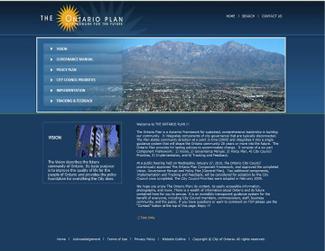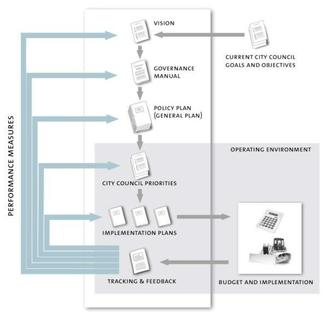
Reinventing the General Plan
A Project of the California Planning Roundtable
With support from the American Planning Association, California Chapter
Great Model: City of Ontario
Featured Principles: Manage Change, Engage the Whole Community, Prioritize Action
- Context
- Web-based Plan
- Directing Growth
- Day-to-Day Guidance
- Challenges and Lessons
- Background Information
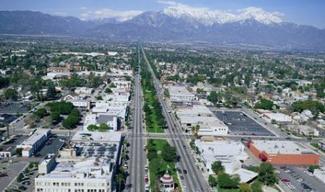
Amid rapid economic and demographic changes, many communities lose sight of the importance of comprehensive planning and vision to ensure a future that matches their values. The City of Ontario, currently a major logistics, transportation, and industrial gateway for San Bernardino County and the Inland Empire, is undergoing a considerable transformation into one of Southern California's next urban centers. Ontario is a model of how the General Plan process and product can be designed and implemented in a manner that makes the General Plan central to guiding such a transformation, with broad support and diverse linkages to nearly every aspect of the city's governance.
The Ontario Plan was from the beginning conceived as a “business plan” connecting the Plan’s long-term strategic vision to fiscal sustainability, aligned with the City's budget and daily operations and a clear framework for implementation. Beginning with a vision of a thriving Ontario in 20-30 years, city leaders created a plan with a framework to ensure that every action of the City would serve these long-range ideals.
After five years of development, The Ontario Plan was unanimously adopted by the City Council in January 2010. Among its notable accomplishments:
-
The Ontario Plan's six components provide a dynamic system for sustained, comprehensive leadership in building, maintaining and governing Ontario. The six components are: 1) Vision, 2) Governance Manual, 3) Policy Plan, 4) City Council Priorities, 5) Implementation, and 6) Tracking and Feedback.
-
The Ontario Plan is entirely web-based, providing easy-to-use access for city officials, city staff, the business community, the general public, and other stakeholders. Its comprehensive web interface can be regularly updated with related news and helpful links to internal and external programs.
-
The Ontario Plan is ultimately a “Plan of Action” that requires the City to frequently reassess and update its provisions and make the Plan the chief guiding document for all major City decisions.
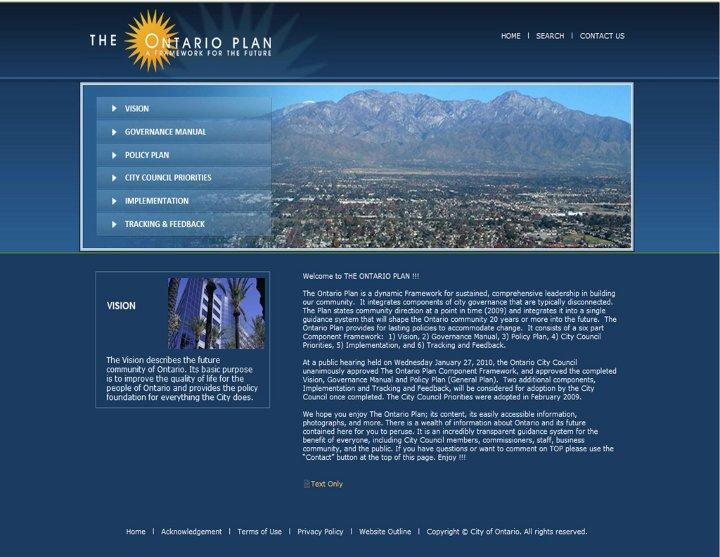
Unlike many general plans, whose online accessibility consists merely as links to a PDF or text file, The Ontario Plan is fully online and interactive. Its paperless format seamlessly integrates the vision, policies, supporting information and implementation measures of the Plan in a user-friendly manner designed to be regularly updated, cross-referenced and easily accessed by City staff, decision-makers, the public and other governmental agencies. Visitors to the website can quickly navigate from one section of the plan to the next. All interested parties are able to easily track the Plan's progress and implementation, and provide feedback along the way. The website has already had extraordinary usage. It has received over 1.2 million visitors in its first 10 months, according to City officials.
In addition to detailing the six components of The Ontario Plan, the website also provides the following convenient features:
- An easy-to-navigate and visually attractive Policy Plan that describes the policies of the City through nine elements
- A sidebar with internal links to various City departments and external links to other agencies and relevant sources.
-
Regular updates featuring news related to The Ontario Plan as well as specific information on the many ways the Plan is being implemented.
-
Direct links to programs consistent with The Ontario Plan’s vision. For example, the "Neighborhoods & Housing" element of the Plan features not only long-term housing goals, but also links to current programs that execute those goals.
-
Performance indicators to track how well goals are being met (under construction).
-
Contact information for questions and comments related to The Ontario Plan.
-
A survey for public feedback on the Governance Manual and Policy Plan components of The Ontario Plan as well as on the usability of the website.
All of these features help make The Ontario Plan's website a successful example of a well-developed, comprehensive and easy-to use online General Plan.

Originally founded as an agricultural enclave on the outskirts of Los Angeles and San Bernardino, during the 20th century Ontario transformed into a suburban community. Ontario once again finds itself undergoing a transformation, this time from a suburb to an urban/regional center. This transformation is due to its location as a gateway connecting Los Angeles County and the Inland Empire, the presence of LA/Ontario International Airport, and its rapidly growing transportation and logistics sectors.
While recognizing and welcoming these changes, Ontario sought to make sure they would be well-guided by a purposeful, community-supported vision for the future. To this end, the Ontario City Council adopted The Ontario Vision in February 2007, the first component of the General Plan framework. The central theme of that Vision is what the city calls “Prosperity by Design,” a goal which connects strong City leadership to creating a vibrant and diverse economy; attracting distinctive, successful commercial and residential development; and a commitment to making The Ontario Plan central to the city's governance.
The strength of The Ontario Plan’s vision lies in its clear acknowledgment of the dramatic changes taking place within the City itself and in the broader Southern California region. The Ontario Plan was specifically designed to provide lasting policies that embrace these changes and recognize the interrelationship between its goals of creating a complete community for its residents and businesses, and accommodating regional growth. As a result, The Ontario Plan’s Vision:
-
Recognizes and builds upon Ontario’s community assets.
-
Supports innovative new technologies and land uses.
-
Seeks economic viability and embraces Ontario’s evolving leadership in the region.
-
Encourages distinctive and well maintained neighborhoods.
-
Promotes a contemporary arrangement of villages in the New Model Colony – roughly 8,000 acres of dairy lands slated for a variety of suburban and urban development.
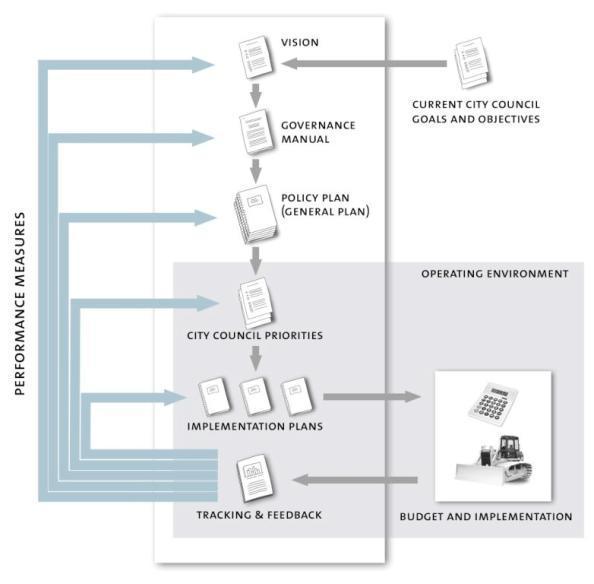
Too many General Plans become static, inflexible documents removed from the day-to-day governance of the city. By contrast, The Ontario Plan is action-oriented and emphasizes ongoing implementation, tracking, and feedback. For example, the City Council Priorities component of the Plan requires the City Council to set annual goals each year consistent with The Ontario Plan’s Vision. These priorities, in turn, help define implementation programs as well as the City’s budget. This transparent method of governance integrates short-term decision making with the long-term guidance provided by The Ontario Plan.
In addition, the City envisioned the General Plan update process as an opportunity to prepare a high-level “business plan” for Ontario that could integrate the City’s long-term goals with daily budgeting and capital investment decisions in order to achieve efficient, fiscally responsible governance. To achieve this goal, the Plan had to be fiscally solvent for covering annual operations and maintenance costs and future capital infrastructure investments. Consequently, The Ontario Plan was integrated into the City’s ongoing annual budgeting and priority setting process and its various master planning programs. The Ontario Plan also necessitates tracking key development, economic indicators, and financial information as an important part of the ongoing implementation and decision-making process. Through these steps, Ontario was able to achieve a Plan that is action-oriented and integrated with the day-to-day functions of City government.
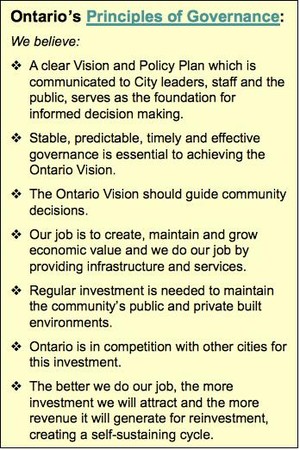
To further ensure that The Ontario Plan continues to maintain its influence on the City, it includes a Governance Manual that establishes high-level, long term governance principles as well as vision-driven goals and policies which support consistent City leadership over time. The Governance Manual requires that The Ontario Plan serve as the foundation for informed decision-making. In addition, it reinforces the notion that every action of the City (including every City Department and Office) and every interaction with the public must be treated as an opportunity to achieve the vision of The Ontario Plan and promote long-term economic and civic prosperity.

The Ontario Plan was developed over approximately four years, and throughout this period a number of lessons were learned that resulted in an innovative and adaptable General Plan. Presented below are several key lessons learned in the process, as identified by planning department staff:
-
The process must be endorsed by City Manager or Mayor. The comprehensive planning process was orchestrated through the City Manager’s office with day-to-day planning management handled by the Planning Department staff. The process benefited enormously from having the City Manager act as the internal champion to marshal the needed resources and buy-in from all City departments and employees as well as the public.
-
An inclusive planning process involving all City departments is critical to success. From the beginning, the City Manager involved all department heads and key management staff in the comprehensive planning process. This ensured that all City Departments were actively engaged in the development of the plan and its ongoing implementation.
-
The City Council’s support is important, too. The City Council’s support of the City Manager and integration of the general plan update process into day-to-day operations increased its long-term effectiveness. In addition, the City Council’s willingness to adopt their annual budget consistent with The Ontario Plan’s vision is crucial to the ongoing implementation of the Plan.
-
The general plan must be a long-range vision that articulates and supports a complete community. Early on, the City set a clear vision for the future of Ontario transitioning into a major urban center in the Inland Empire while respecting the neighborhood functions of its residential and downtown areas. Through extensive outreach in a variety of venues, both citywide and at the neighborhood level, the Plan gained strong community and business support, and was adopted unanimously by the Planning Commission and the City Council.
-
Establish a policy plan focused on long-range goals. Maintaining focus on long-range goals in the Policy Plan (general plan), as distinct from shorter-term strategy and implementation, is important because it allows the City to respond to change in order to achieve its vision without necessarily having to modify general plan content. It also helps provide continuity and the certainty needed for stakeholder investment in the community.
-
A mid-range strategy of current policies, programs and priorities is also important to guide day-to-day activities. In order to achieve its long-range goals, the City realized it had to have a set of short-term and mid-term strategies that could deal with the economic and budget realities of today while building towards a future that would require significant investment in public infrastructure.
-
The plan must be action-oriented and linked to annual budget. In order to create an effective plan that could be implemented, the City chose an action-oriented approach that linked the Plan to the annual budgeting process and a system of monitoring and tracking indicators. Every department in the City is responsible for ensuring its activities support the Plan and its vision.
-
The plan must be accessible and transparent. To achieve this goal, the City utilized an innovative web-based design that allows individuals to easily access planning information and to obtain responses to questions and comments in a timely manner.
-
Implementation – a continuous planning process – is the key to success. Now that The Ontario Plan has been adopted, the City is moving forward in developing Tracking & Feedback and Implementation systems that will realize its underlying vision and long-range goals.

Community Description
The City of Ontario is located in the southwest corner of San Bernardino County, roughly 35 miles east of downtown Los Angeles. As of January 1, 2010, the City’s population was 174,536, an increase of about 10.5 percent since 2000. According to City sources, the current population is roughly 47 percent Hispanic, 31 percent Caucasian, and 22 percent other racial and ethnic groups. The median age in the City is 30.2 years old.
The average household income in the City of Ontario was $64,702 in 2008. The largest employment sectors in the City are Distribution (23 percent of total city employment), Retail Trade (16 percent), and Manufacturing (15 percent). However, the fastest growing sectors since 2000, excluding Help Agencies, are Business Services (up 114 percent) and Financial Institutions, Insurance, and Real Estate (up 109 percent). As of 2009, the largest employers in the City were the LA/Ontario International Airport (7,690 employees), United Parcel Service (3,500 employees) and supermarket chain Pro & Sons, Inc., which is based in Ontario (1,575 employees).
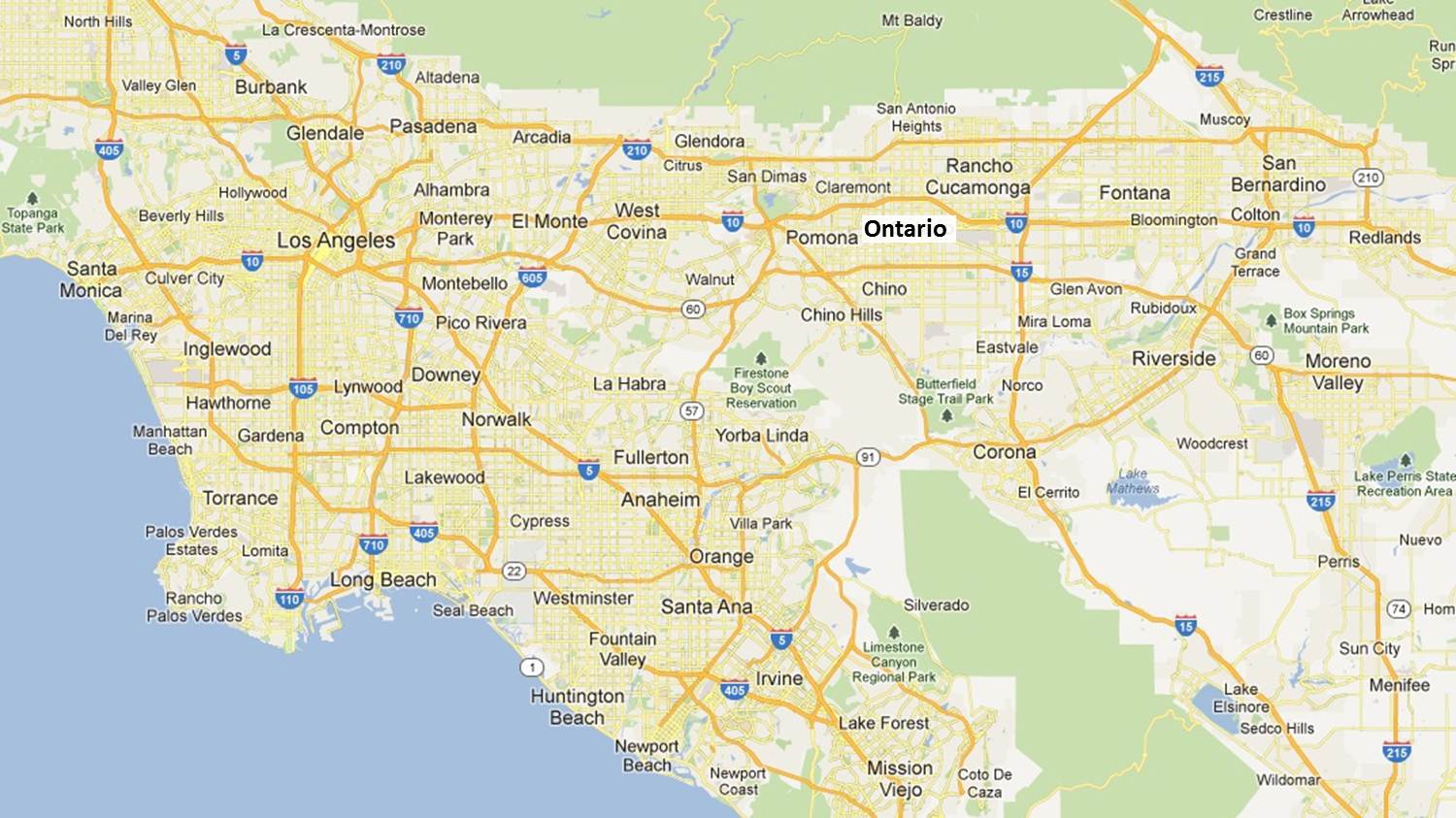
Timeframe of Plan Development
The City of Ontario initiated the revision of its general plan in 2005. In February 2009, the City Council Priorities were adopted, and then on January 27, 2010, the City Council approved The Ontario Plan’s Component Framework as well as the completed Vision, Governance Manual and Policy Plan portions of the Plan. The final two components of The Ontario Plan – Implementation and Tracking and Feedback - are still pending completion.
Keeping on Track
Originally, the General Plan update was designed as a 2-3 year program. At the end of three years, The Ontario Plan was ready for adoption, but because of the new global warming and greenhouse gas issues that needed to be addressed under the recently adopted AB 32 and SB 375 legislation, the City decided to submit their draft of the General Plan and Environmental Impact Report to the State of California’s Attorney General’s office for their review and comment. That discussion took an additional nine months in order to further explain and study the City’s contention that the new general plan would reduce green house gasses and was consistent with the Southern California Association of Governments (SCAG) regional Compass Blueprint and sustainable communities strategies.
Public Participation & Stakeholder Involvement
The City of Ontario consistently partnered with other public agencies, private entities and local citizens throughout the development of The Ontario Plan.
Initially, the public was invited to three citywide open houses to provide input on a citywide vision and explore ways to create better places in an interactive setting. These sessions were advertised over the radio, through newspapers and local grocery stores, by contacting different community organizations and on the City’s website. However, these sessions were not well attended.
The City also held one focus area workshop that examined ways to enhance the west side of downtown Ontario. Working with the lead general plan consultant, Project for Public Spaces (PPS), a nonprofit organization dedicated to helping people create and sustain public places that build stronger communities, held a “Power of 10” workshop. The public was invited to tour downtown Ontario, and then identify and discuss 10 things they liked about the City and 10 things they liked about their neighborhoods and what changes they would like to see. This workshop was very successful and well attended, with over 75 people in attendance. As a result of the success of this workshop, City staff has decided to use this approach in future community workshops that will help shape future neighborhood improvement programs.
Concurrently during the preparation of the Housing Element, which was certified by the California Department of Housing and Community Development, several workshops were held in low and moderate-income neighborhoods and with housing advocacy groups. These neighborhood meetings were better attended with 30 – 40 people present.
Additionally, the consultant identified key business, city and community leaders and conducted a series of one-on-one interviews to determine what these individuals liked about the city, what they felt needed to be improved and where they saw the city going in the future.
This was followed by a Strategic Advisor Series, whereby the City hosted 6 strategic planning meetings on key issues that needed to be addressed, including: 1) growth, 2) transportation, 3) housing, 4) health, education and culture, 5) urban design and 6) infrastructure. Each meeting was led by the City Manager and included a panel of regional and national experts who where invited to discuss the selected topic, share their experiences, and brainstorm new ideas and solutions to these issues. These meetings were attended by 30 – 40 people, in addition to roughly ten to twelve department heads and city staff.
Other City Departments’ Involvement
All the City department heads and key managers were involved in The Ontario Plan from its inception. A key decision made early on was that the entire process would be led out of the City Manager’s office, with the Planning Department managing the day-to-day activities and ensuring that the proper documents and policies were prepared. In addition to the Planning Department, other departments that were represented included: Public Works, Finance, Police, Fire, Engineering, Parks and Recreation, Libraries and Museum. Input from all City Departments was critical to the integration of The Ontario Plan into the day-to-day governance of the City.
Legal and Policy Context
Because of the new global warming/greenhouse gas reduction legislation – AB 32 and SB 375 – the City was proactive in contacting the Attorney General’s office to address those issues. In addition, the planning staff contacted the California Office of Planning and Research early in the process to review a preliminary version of the web-based plan and to get feedback regarding whether they had any concerns about a paperless general plan.
Consideration of Regional Issues
As the “Gateway to the Inland Empire,” the City of Ontario provides an important link between Los Angeles County and San Bernardino and Riverside Counties. In addition, the LA/Ontario International Airport is the centerpiece of one of the fastest growing transportation and freight movement systems in the United States, giving the City of Ontario a global connection. Recognizing Ontario’s critical importance to the Southern California regional economy, The Ontario Plan identifies the City’s need to be an active participant and leader in identifying and developing solutions to transportation, economic, and quality of life issues through cooperative regional and sub-regional planning efforts. For example, the Transportation component of The Ontario Plan explicitly directs Ontario to take a proactive leadership role in identifying and implementing strategies that address long-term regional transportation challenges in coordination with Los Angeles World Airports, Caltrans, SCAG, and other transportation agencies.
Community Reaction
The response of the residential and business communities to The Ontario Plan has been very positive. The City’s extensive outreach not only educated the constituents about the process and the key issues, but provided invaluable feedback. In addition, one of the most effective means of ensuring ongoing community involvement has been The Ontario Plan's website. The City reported the website received over 1.2 million visitors in its first 10 months, and includes features for comments or questions where the City staff will respond within 24 hours.
Implementation Features
While drafting The Ontario Plan, the City was committed to creating a dynamic document with an implementation and tracking system designed to provide transparency and measure progress towards the Plan’s long-term Vision. As a result, Implementation is one of the six framework components of The Ontario Plan. Although this component has not yet been completed (as of October 2010), once it is, visitors to The Ontario Plan’s website will be able view actions taken to carry out Plan policies, including initiatives, decisions on public and private development projects and activity programs. The motivation behind the implementation section is to keep The Ontario Plan relevant, current and responsive to economic, environmental, and social conditions as they develop in Ontario as well as in Southern California and beyond.
Connection to Jurisdictional Budget
In conjunction with the emphasis on implementation, The Ontario Plan is aligned with the City’s budget, decision-making process and daily operations. Unlike most general plans, three of the six framework components of The Ontario Plan – City Council Priorities, Implementation, and Tracking and Feedback – are specifically tied to the operational environment of the City. The City’s budget has a direct influence on these three operational components of The Ontario Plan; and conversely, they have a similar influence on the City’s budget.
Adaptability
The Ontario Plan is flexible because it is linked to the annual budgeting and priority-setting process. In addition, key indicators will be monitored and tracked in order to evaluate the overall performance of the Plan. And, because it is web-based, it can be easily modified and updated online.
Accessibility
Thanks to its fully-interactive, easy-to-use website (see “Planning Online”), The Ontario Plan is extremely accessible to the public and staff.
Organization
While The Ontario Plan includes the standard seven mandatory elements (land use, circulation, housing, conservation, open space, noise, and safety), the City views it as a “Comprehensive Plan” that goes even further by including issues of interest that are not typically included, such as Health Care and Education.
Costs
The Planning Director has not tracked the actual in-house costs, but gave a rough estimate of $600,000 over the three-year period. In-house staff within the Planning Department consisted of the Planning Director (40% time allocated over three years); the Head of Advance Planning (60% time allocation); and a Senior Planner (90% time allocation). Also, no estimate can be provided for the time spent by all of the Department Heads, managers and staff from other participating departments.
The overall budget for the consultant team, led by The Planning Center, was $3.0 million over a three-ear period. To date, the entire planning process has stayed within this budget, including the implementation of the web-based Plan. The web-based approach was not part of the original scope, but this additional work stayed within the overall allocated budget of $3.0 million. Also, under the original budget, there is still work taking place on the tracking and implementation aspects of the Plan.
Actual Costs vs. Expected Costs
The overall planning process has stayed within its original budget, even with all of the issues covered, including the extensive outreach, the web-based approach and coordination with the Attorney General’s office.
Adoption Process
The adoption process took place over approximately three months. Prior to the adoption process, there were four joint Planning Commission/City Council workshops at key milestones. Then, a draft of The Ontario Plan was taken back for two neighborhood meetings followed by another joint Planning Commission/City Council workshop. Additionally, one Planning Commission public hearing was held followed by one City Council public hearing. Generally, the public adoption process went very smoothly, largely because of the extensive outreach and interaction with the community that was facilitated over the three year planning period.
CEQA Review
The CEQA was process was completed within the original budget and staff did not have a specific estimate for the cost of that work. Several extra key issues covered related to: noise and height restrictions due to the airport flight paths, both existing and future; the adequacy of water supply due to an approximate doubling of the population and tripling of the jobs under the plan; and global warming/greenhouse reduction issues.
The airport issues were handled by changing land use designations within the flight paths and creating “transition overlays.” These overlay areas are within the over-flight area of LA/Ontario International Airport and are impacted by noise and dust. The overlays allow residential uses to transition to Business Park or Industrial land use if an entire block can be recycled to a business park or industrial use. In these cases, the City is responsible for the necessary amendments to the Policy Plan Manual and Development Code.
There were also questions regarding the adequacy of the water supply due to the increased water demand projected from new growth. The City addressed the supply issue by giving more attention to recycling water and allocating the right type of water for its efficient use.
The global warming/greenhouse gas reduction issue was largely handled through coordination with the Attorney General’s office, and included about 32 pages of potential measures to be considered in an ongoing process after the Plan’s adoption. The City has committed to developing a Climate Action Plan within 18 months after the adoption of The Ontario Plan.
Legal Challenges
The Ontario Plan has not faced any legal challenges largely because the key issues were identified and addressed throughout the planning and CEQA process. Also, the recently adopted global warming/greenhouse gas issues were addressed in a proactive manner.
Project Management Team
The following people constituted the overall Project Management Team that met every other week throughout the course of the project and were intimately involved in every aspect of The Ontario Plan.
City of Ontario Staff
-
Greg Devereaux, former City Manager
-
Jerry Blum, Planning Director
-
Cathy Wahlstrom, Principal Planner
-
Melanie Mullis, Senior Planner
Consultants
-
Brian Judd, Project Manager, The Planning Center
-
Kati Rubinyi, Senior Research & Design Specialist, The Planning Center
-
Al Bell, Strategic Advisor, Al Bell Consulting
-
Paul Ireland, City’s Management-3rd Party Review Consultant, Hogle-Ireland.
Accessing the Plan
The Ontario Plan is available online at http://www.ontarioplan.org/.
Name of CPR Preparers of this Model
Stan Hoffman and Cathy Creswell, with assistance from Dan Kurz
Name of Primary Point(s) of Contact at the Jurisdiction
Jerry Blum, Planning Director
CPR Peer Reviewers
David Booher, Linda Dalton and Al Zelinka
CPR Project Team
Elaine Costello, Project Manager; Project Co-Chairs Cathy Creswell and Janet Ruggiero; Craig Beebe, Project Assistant
Funding
The Catalog
Our catalog contains a number of General Plan "Great Model" examples. Browse the entire catalog
Browse by Principle
- Create a Vision
- Manage Change
- Make Life Better
- Build Community Identity
- Promote Social Equity and Economic Prosperity
- Steward and Enhance the Environment
- Engage the Whole Community
- Look Beyond Local Boundaries
- Prioritize Action
- Be Universally Attainable
Browse by tag:
awards city climate-change context county equity graphics growth-management health implementation infill mature-community organization participation preservation redevelopment region rural smart-growth suburban sustainability town urban urban-design web-strategies
